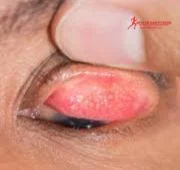Giant Papillary Conjunctivitis: Managing an Irritating eye Condition.
Giant Papillary Conjunctivitis (GPC) is an irritating eye disorder that influences the conjunctiva (the thin membrane covering the whites of the eyes and the inner surface of the eyelids). This article will explore the causes, symptoms, diagnosis, and treatment options for Giant Papillary Conjunctivitis.

What is giant papillary conjunctivitis (GPC)?
GPC is an inflammatory eye condition in which elevated, large papillae or bumps appear on the inner surface of the upper eyelid. These
papillae may vary in size, but they are usually larger than the papillae
present in other types of conjunctivitis. Giant papillary Conjunctivitis
typically affects both eyes and is often associated with the use of contact
lenses or ocular prostheses.
Editor's picks
8 Interesting myths and facts about the pink eye
Syrinjoma bumps under the eye, causes, treatment
Symptoms:
What are the symptoms of giant
Papillary conjunctivitis?
The symptoms of GPC
can vary in intensity and may include:
- Itching
- Redness (The eyes may appear red or bloodshot due to
inflammation of the conjunctiva.)
- Foreign Body Sensation (a feeling of having a foreign
body or sand in the eyes)
- Tearing (excessive tearing or watery eyes)Blurred
Vision (temporary blurring of vision)
- Mucous Discharge (Stringy or mucus-like discharge)
Causes
What are the causes and risk factors?
GPC is primarily associated with allergic reactions to foreign materials present in the eye, such as contact lenses, prosthetic eyes, sutures, or ocular medications. Prolonged exposure to these irritants can trigger an immune response, leading to the development of the characteristic papillae on the inner eyelid surface.Some common causes and risk factors include:
1. Contact lens use
Extended wear of contact lenses, especially when proper cleaning and disinfection practices are not followed, can cause protein and lipid deposits on the lenses. These deposits can induce an allergic response in some individuals, leading to GPC.2. Prosthetic eyes
People with artificial eyes or ocular prostheses may develop GPC
due to mechanical friction between the prosthesis and the conjunctiva.
3. Eye surgeries
Following eye
surgeries, such as cataract removal or corneal transplant, the presence of sutures or other foreign materials can trigger an immune reaction.
4. Eye drops and medications
Prolonged use of
certain eye drops or medications can lead to GPC, especially those containing
preservatives.
5. Allergic reactions
Individuals with a history of allergies, hay fever, or asthma may be more prone to developing GPC.
Editor's picks
Milia bumps under the eye, causes, treatment
Diagnosis
How does giant papillary conjunctivitis
diagnose?
If you experience constant symptoms of GPC, it is crucial to consult an eye specialist for an appropriate diagnosis. The eye doctor will evaluate your medical history, conduct a complete eye examination, and may suggest additional tests to confirm giant papillary conjunctivitis.Treatment
What are the treatment options for
giant papillary conjunctivitis?
Treatment options for GPC aim to alleviate symptoms, reduce inflammation, and eliminate the underlying cause. Depending on the severity of the condition, the following approaches may be employed:1. Discontinuing contact lens use
If GPC is associated with contact lens
wear, the eye doctor may advise temporarily discontinuing lens use or switching
to a different type of lens.
2. Medications
Eye drops containing antihistamines, mast
cell stabilizers, or corticosteroids may be prescribed to manage inflammation
and relieve symptoms.
3. Cold compresses
Applying cold compresses to the eyes can help soothe irritation and reduce swelling.4. Artificial tears
Lubricating eye drops can provide relief from dryness and discomfort.5. Proper hygiene
Maintaining proper eye hygiene, including regular cleaning of contact lenses and avoiding eye rubbing, can prevent exacerbation of symptoms.6. Avoiding allergens
Identifying and avoiding allergens that trigger GPC can help prevent recurrent episodes.Read also 23 signs you grew up with Ehler-Danlos Syndrome
Prevention
How can I prevent giant papillary
conjunctivitis?
While not all cases of GPC can be prevented, certain measures can minimize the risk:1. Proper contact lens care: Follow your eye care professional's instructions for cleaning, disinfecting, and wearing contact lenses.
2. Regular eye examinations: Routine eye check-ups can help detect GPC and other eye conditions early, allowing for timely intervention.
3. Allergy management: If you have known allergies, work with your healthcare provider to manage them effectively.
Conclusion
Giant Papillary Conjunctivitis can be an irritating and uncomfortable eye condition, affecting individuals who wear contact lenses, have artificial eyes, or undergo eye surgeries. Timely diagnosis and appropriate management are crucial to alleviate symptoms and prevent complications. If you experience persistent eye discomfort or changes in vision, seek professional eye care promptly to identify and address the underlying cause of the problem. Remember, healthy eyes are essential for a better quality of life, so take care of them with diligence and attention.





.jpg)
Post a Comment